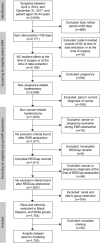Ethnoracial Differences in Premenopausal Hysterectomy: The Role of Symptom Severity
- PMID: 37473411
- PMCID: PMC10351903
- DOI: 10.1097/AOG.0000000000005225
Ethnoracial Differences in Premenopausal Hysterectomy: The Role of Symptom Severity
Abstract
Objective: To evaluate whether greater symptom severity can explain higher hysterectomy rates among premenopausal non-Hispanic Black compared with White patients in the U.S. South rather than potential overtreatment of Black patients.
Methods: Using electronic health record data from 1,703 patients who underwent hysterectomy in a large health care system in the U.S. South between 2014 and 2017, we assessed symptom severity to account for differences in hysterectomy rates for noncancerous conditions among premenopausal non-Hispanic Black, non-Hispanic White, and Hispanic patients. We used Poisson generalized linear mixed modeling to estimate symptom severity (greater than the 75th percentile on composite symptom severity scores of bleeding, bulk, or pelvic pain) as a function of race-ethnicity. We calculated prevalence ratios (PRs). We controlled for factors both contra-indicating and contributing to hysterectomy.
Results: The overall median age of non-Hispanic White (n=1,050), non-Hispanic Black (n=565), and Hispanic (n=158) patients was 40 years. The White and Black patients were mostly insured (insured greater than 95%), whereas the Hispanic patients were often uninsured (insured 58.9%). White and Black patients were mostly treated outside academic medical centers (nonmedical center: 63.7% and 58.4%, respectively); the opposite was true for Hispanic patients (nonmedical center: 34.2%). Black patients had higher bleeding severity scores compared with Hispanic and White patients (median 8, 7, and 4 respectively) and higher bulk scores (median 3, 1, and 0, respectively), but pain scores differed (median 3, 5, and 4, respectively). Black and Hispanic patients were disproportionately likely to have severe symptoms documented on two or more symptoms (referent: not severe on any symptoms) (adjusted PR [Black vs White] 3.02, 95% CI 2.29-3.99; adjusted PR [Hispanic vs White] 2.61, 95% CI 1.78-3.83). Although Black and Hispanic patients were more likely to experience severe symptoms, we found no racial and ethnic differences in the number of alternative treatments attempted before hysterectomy.
Conclusion: We did not find evidence of overtreatment of Black patients. Our findings suggest potential undertreatment of Black and Hispanic patients with uterine-sparing alternatives earlier in their disease progression.
Copyright © 2023 by the American College of Obstetricians and Gynecologists. Published by Wolters Kluwer Health, Inc. All rights reserved.
Conflict of interest statement
Financial Disclosure Whitney R. Robinson receives research funding and support as a co-investigator (1R01AG077947-01) from the National Institute of Aging (NIA). She has received honoraria (<$1,000) for speaking at institutions such as the University of Wisconsin School of Medicine and Public Health, and she has received honoraria for serving on a standing study section for the National Institutes of Health (NIH). Erin T. Carey provides expert witness testimony for Southern Insurance, Beytin McLaughlin, and Wagstaff. She has received payment from BriannaCope, StockmanConnor, and McBridehall. She also has two provisional patents unrelated to this work:421/518 PCT; U.S. Provisional No. 63/322,886; DEC POA UNC 19-0083 U.S. 17/769,042 (Our Ref. 421/465 PCT/US). Evan R. Myers disclosed receiving payment from Merck for HPV vaccination and Moderna for CMV vaccination. He has received payment from AbbVie, Inc. and Hologic, Inc. (cervical cancer screening). Til Stürmer receives investigator-initiated research funding and support as Principal Investigator (R01AG056479) from the National Institute of Aging (NIA). He owns stock in Novartis and Roche and received payment from Novo Nordisk. The other authors did not report any potential conflicts of interest.
Figures
Similar articles
-
Associations between race and ethnicity and perioperative outcomes among women undergoing hysterectomy for adenomyosis.Fertil Steril. 2024 Jun;121(6):1053-1062. doi: 10.1016/j.fertnstert.2024.02.003. Epub 2024 Feb 10. Fertil Steril. 2024. PMID: 38342374
-
The role of race and ethnicity in the State Children's Health Insurance Program (SCHIP) in four states: are there baseline disparities, and what do they mean for SCHIP?Pediatrics. 2003 Dec;112(6 Pt 2):e521. Pediatrics. 2003. PMID: 14654674
-
The Carolina hysterectomy cohort (CHC): a novel case series of reproductive-aged hysterectomy patients across 10 hospitals in the US south.BMC Womens Health. 2023 Dec 19;23(1):674. doi: 10.1186/s12905-023-02837-8. BMC Womens Health. 2023. PMID: 38114962 Free PMC article.
-
Changing trends in Black-White racial differences in surgical menopause: a population-based study.Am J Obstet Gynecol. 2021 Nov;225(5):502.e1-502.e13. doi: 10.1016/j.ajog.2021.05.045. Epub 2021 Jun 8. Am J Obstet Gynecol. 2021. PMID: 34111405 Free PMC article.
-
Performance of racial and ethnic minority-serving hospitals on delivery-related indicators.Am J Obstet Gynecol. 2014 Dec;211(6):647.e1-16. doi: 10.1016/j.ajog.2014.06.006. Epub 2014 Jun 5. Am J Obstet Gynecol. 2014. PMID: 24909341
Cited by
-
Ethno-Racial Differences in Age and Symptom Severity Among Pre-Menopausal Women Commencing Treatment for Benign Gynecological Conditions with a Levonorgestrel-Releasing Intrauterine Device.Health Equity. 2025 Jun 11;9(1):326-338. doi: 10.1089/heq.2024.0238. eCollection 2025. Health Equity. 2025. PMID: 40642026 Free PMC article.
-
Education level is associated with the occurrence and timing of hysterectomy: A cohort study of Canadian women.Acta Obstet Gynecol Scand. 2024 Nov;103(11):2211-2220. doi: 10.1111/aogs.14959. Epub 2024 Sep 2. Acta Obstet Gynecol Scand. 2024. PMID: 39223035 Free PMC article.
-
The relation of heavy or prolonged bleeding during the menopause transition to risk of hysterectomy.Womens Health (Lond). 2025 Jan-Dec;21:17455057251351418. doi: 10.1177/17455057251351418. Epub 2025 Jul 10. Womens Health (Lond). 2025. PMID: 40637738 Free PMC article.
-
Systematic review and meta-analysis of the pelvic organ prolapse and vaginal prolapse among the global population.BJUI Compass. 2024 Dec 10;6(1):e464. doi: 10.1002/bco2.464. eCollection 2025 Jan. BJUI Compass. 2024. PMID: 39877583 Free PMC article. Review.
References
Publication types
MeSH terms
Grants and funding
LinkOut - more resources
Full Text Sources
Medical
Research Materials


